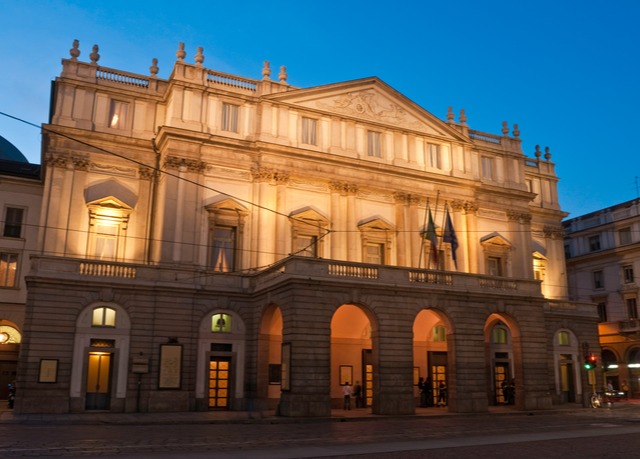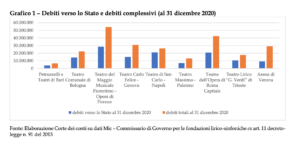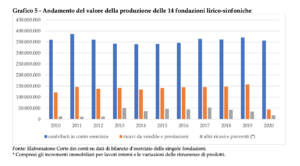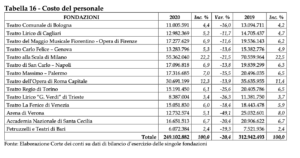This is how much the accounts of the lyric and symphonic foundations depend on the state

The Court of Auditors does the "pocket accounts" of the opera and symphony foundations: in 2021 they received almost 200 million euros but approximately 131 million euros remain in debt
The Court of Auditors has approved the 2020 management report of the opera-symphony foundations . The findings of the accounting magistrates provide a picture of the dependence of cultural institutes on public resources which constitute "85% of the total operating contributions, while resources coming from private individuals represent only around 15%". The symphonic opera foundations are unable to support themselves independently, the "foundations' own resources (income from sales and services) are insufficient to cover management costs"
HOW THE ITALIAN LYRIC SYMPHONIC FOUNDATIONS ARE BORN
The report recalls that the first public intervention in the opera-symphonic sector dates back to more than a century ago: with the royal decree of 29 December 1921, n. 2143, the autonomous Teatro alla Scala of Milan was established. Subsequently, the Rome Opera was born in 1929, followed, three years later, by the autonomous body of Florence and in 1936 by the autonomous opera bodies in Turin, Venice, Trieste, Verona , Genoa, Bologna, Naples and Palermo.
WHAT ARE THE 14 ITALIAN LYRIC SYMPHONIC FOUNDATIONS
In our country there are 14 autonomous opera bodies which have been recognized as legal personalities under public law. These are eleven opera theatres, the Teatro Comunale di Bologna, the Teatro Comunale di Firenze (now, Fondazione Teatro del Maggio musicale fiorentino), the Teatro Comunale dell'Opera di Genova (now, Fondazione Teatro Carlo Felice), the Teatro alla Scala of Milan, the San Carlo Theater of Naples, the Teatro Massimo of Palermo, the Teatro dell'Opera of Rome, the Teatro Regio of Turin, the Teatro Comunale Giuseppe Verdi of Trieste, the Teatro La Fenice of Venice and the Arena of Verona , of two similar concert institutions, the National Academy of S. Cecilia of Rome and the Giovanni Pierluigi da Palestrina Concert and Lyric Theater Institution of Cagliari (now the Lyric Theater Foundation), finally, the latest addition is the Fondazione Petruzzelli and Theaters of Bari. For these cultural institutions the "burdens of restructuring the budgets of foundations in situations of economic and financial difficulty" are borne by the State.
THE BALANCE SHEETS OF THE ITALIAN SYMPHONIC OPERA FOUNDATIONS AND THE CHARGES FOR THE STATE
The report highlights that since 2020 the assets have grown by 17,022,671 euros (+1.6%), going from 1,059,080,662 to 1,076,103,333. Credits also increased by 25.5% while financial liabilities, excluding net equity, showed an increase of 0.7%. Overall, “the net assets of the Opera and Symphony Foundations reach 461,864,928 euros (+2.9%) while the available net assets show a general improvement (33.4%) compared to the previous year. The value of production was equal to 417,674,614 euros (-144,935,353)”.

THE RECOVERY PLANS
Nine of these have presented a recovery plan for 2014-2016 (Petruzzelli and Theaters of Bari, Teatro Massimo of Palermo, Teatro del Maggio Musicale Fiorentino, Teatro di San Carlo in Naples, Teatro Lirico G. Verdi of Trieste, Teatro dell' Opera of Rome, Teatro Comunale of Bologna, Teatro Carlo Felice of Genoa and Arena of Verona) to which the Teatro Regio of Turin was also added in 2021. The possibility of accessing a revolving fund for the granting of loans with a duration of up to a maximum of 30 years has been envisaged.
THE DEBTS OF THE LYRIC SYMPHONY FOUNDATIONS
The overall debt of the foundations towards the State (towards the MEF and the MIC) for the repayment of the loans is equal to 131,045,026 euros. However, the overall amount of debts decreased by 8.1% thanks to the recovery plans. However, debts to suppliers, social security institutions and employees remain high.

THE ECONOMIC COSTS OF THE COVID 19 PANDEMIC
During the Covid 19 pandemic, the opera and symphony foundations suffered from the closures imposed by the containment of the pandemic. A cost that translated into losses calculated at around 100 million euros. It should be underlined that 50% of the expenses of symphonic opera foundations are allocated to personnel costs. To guarantee employment during the closures of the pandemic phase, the Supplementary Wage Fund (Fis) was decisive. Until 31 December 2020, 156.2 million euros have been allocated, totally disbursed to the individual foundations. Furthermore, in the two-year period 2020 – 2021, another 20 million were disbursed to the opera and symphony foundations.

THE STAFF EMPLOYED DECREASES IN 2020
As mentioned, personnel costs represent 50% of the costs of the opera and symphony foundations. 2020 saw a slight decrease (-7.6%) in human resources, and in the corresponding costs which went from 312,942,493 to 249,102,882 euros (-20.4%). “The number of negotiation activities also fell (-3,561), with a drop in the overall value of 12.1 million euros – we read in the note accompanying the report -. Direct assignments cover approximately 48%. Requests for offers (RDOs) on MePa and subscriptions to Consip agreements also decreased".

THE FINANCING OF LYRIC SYMPHONY FOUNDATIONS
The Single Entertainment Fund is the main source of state funding. FUS financially supports bodies, institutions, associations, organizations and businesses operating in the sectors of musical, dance, theatrical, circus and traveling entertainment activities, and in the promotion and support of events and initiatives of national character and importance to be carried out in Italy or abroad. In 2020 it allocated almost 183 million euros to the sector (52.38% of the total availability of the Fund itself). Further interventions to support the opera-symphonic sector came from the budget law for 2021 which provided for:
- the increase in the revolving fund of €40 million for 2021;
- the 20 million limit of funding attributable to each foundation;
- the extension of the functions of the Government Commissioner until 31 December 2022.
Therefore, the Opera and Symphony Foundations received 198.1 million in 2021 (divided into advances of 23.1 million and a revolving fund of 175 million). Furthermore, the 2022 Budget Law has allocated 100 million euros for the year 2022 and 50 million for the year 2023 "destined to increase the endowment fund of the FLS, reserving a portion of no less than 100 million for foundations with specific economic-patrimonial problems".

HOW THE FUS FUNDS ARE DISTRIBUTED
The allocation of FUS funds follows the following criteria:
- 50% of the share is divided in consideration of the production costs deriving from the activities carried out by each foundation in the year preceding the one to which the distribution refers, on the basis of production indicators;
- 25% of the share is divided in consideration of the improvement of management results through the ability to find resources;
- 25% of the fee is divided in consideration of the artistic quality of the programs.
IN 2020 THE AVAILABILITY OF THE OPERA SYMPHONY FOUNDATIONS DECREASED BY 5.5%
As stated in the report of the Court of Auditors, in 2020 the overall amount of the Fus increased by 538,800 euros compared to that of the previous year. The foundations benefited from additional availability (20,686,012 euros, compared to 33,186,009 euros in 2019) deriving from different laws; from this it follows that the total amount of resources available is equal to 203,498,812 euros (215,460,009 euros in 2019), with a decrease of 5.5%. The FUS funds were distributed as follows: at La Scala in Milan and the National Academy of Santa Cecilia are entitled, as per the ministerial decree of 10 April 2015, to 30,040,012 euros and 12,291,192 euros respectively, the remaining portion of the Fund is divided among the remaining foundations, in particular, a contribution exceeding 18 million is attributed to the Teatro dell'Opera di Roma Capitale, that due to the Fondazione Teatro La Fenice of Venice exceeds 15 million, while that of the Teatro del Maggio Musicale Fiorentino – Opera of Florence is around 14 million. The Teatro Lirico Foundation of Cagliari receives the lowest contribution, equal to 8,181,597 euros; amounts lower than 10 million euros also include the Teatro Comunale di Bologna, Teatro Lirico di Cagliari, Petruzzelli e Teatri di Bari33 and Teatro Lirico Giuseppe Verdi di Trieste foundations.
The following table shows, in particular, the distribution of the FUS for opera-symphonic foundations over the period 2010 – 2020.
OTHER FORMS OF FINANCING FOR OPERA AND SYMPHONY FOUNDATIONS
But, as mentioned, symphonic opera foundations also receive other funding. In detail:
- contribution provided for by law no. 232 of 2016, for all FLS, equal to 15 million euros;
- total contribution of 1,859,359 euros, provided for by law 23 December 2000, n. 388, in favor of all FLS;
- contribution of 2,704,030 euros, provided for by the same law no. 388 of 2000, assigned to the Teatro alla Scala in Milan and the Teatro dell'Opera di Roma in equal parts (respectively as a body of particular national interest in the musical field and for the representative function as state capital);
- contribution of 872,622 euros, intended for the Carlo Felice Foundation of Genoa, by virtue of law no. 24 December 2003. 350;
- contribution of 250 thousand euros for the Accademia Nazionale di Santa Cecilia, as compensation for the expense relating to the emoluments of the teachers of the specialization courses referred to in the art. 12, c. 8- bis , of the legislative decree of 20 June 2017 n. 91, converted into law 3 August 2017, n. 123.
This is a machine translation from Italian language of a post published on Start Magazine at the URL https://www.startmag.it/economia/tutti-i-conti-in-rosso-delle-fondazioni-lirico-sinfoniche/ on Mon, 11 Sep 2023 05:21:00 +0000.
